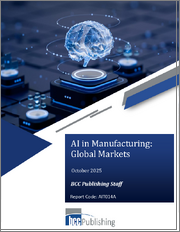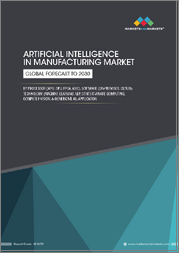
|
시장보고서
상품코드
1687611
제조업용 인공지능(AI) 시장 규모, 점유율, 성장 분석 : 제공별, 기술별, 용도별, 업계별, 지역별 - 산업 예측(2025-2032년)Artificial Intelligence (AI) in Manufacturing Market Size, Share, and Growth Analysis, By Offering (Hardware, Software), By Technology (Machine Learning, Natural Language Processing), By Application, By Industry, By Region - Industry Forecast 2025-2032 |
||||||
제조업용 인공지능(AI) 시장 규모는 2023년에 162억 달러로, 예측 기간(2025-2032년)의 CAGR은 45.6%로, 2024년 235억 9,000만 달러에서 2032년에는 4,764억 달러로 성장할 전망입니다.
2023년 10월 현재, 제조 분야는 분석, 증강지능, 가상현실, 스마트 포장, 적층제조와 같은 첨단 기술에 힘입어 인공지능(AI)의 도입이 크게 증가하고 있습니다. 유연성과 지속가능한 솔루션에 대한 수요 증가는 이러한 성장에 있으며, 매우 중요합니다. 또한 자동화 및 빅데이터 통합에 대한 의존도가 높아지면서 시장 기회가 확대되고 있습니다. 머신비전 카메라는 기계 추적, 물류, 현장 서비스, 품질관리 등의 용도를 강화하는 등 점점 더 널리 보급되고 있습니다. 이러한 상황에서 주목할 만한 발전은 Databricks가 2023년 4월에 제조업체를 위한 Databricks Lakehouse를 출시한 것입니다. Databricks Lakehouse는 DuPont와 같은 업계 리더들이 성공적으로 채택한 사전 개발된 AI 솔루션을 특징으로 합니다.
목차
서론
- 조사의 목적
- 조사 범위
- 정의
조사 방법
- 정보 조달
- 2차와 1차 데이터 방법
- 시장 규모 예측
- 시장의 전제조건과 제한
개요
- 세계 시장 전망
- 공급과 수요 동향 분석
- 부문별 기회 분석
시장 역학과 전망
- 시장 개요
- 시장 규모
- 시장 역학
- 촉진요인과 기회
- 억제요인과 과제
- Porter의 산업 분석
주요 시장 인사이트
- 주요 성공 요인
- 경쟁의 정도
- 주요 투자 기회
- 시장 에코시스템
- 시장의 매력 지수(2024년)
- PESTEL 분석
- 거시경제 지표
- 밸류체인 분석
- 가격 분석
- 기술의 진보
제조업용 인공지능(AI) 시장 규모 : 제공별 & CAGR(2025-2032)
- 시장 개요
- 하드웨어
- 소프트웨어
- 서비스
제조업용 인공지능(AI) 시장 규모 : 기술별 & CAGR(2025-2032)
- 시장 개요
- 기계학습
- 자연언어처리
- Aware Computing
- 컴퓨터 비전
제조업용 인공지능(AI) 시장 규모 : 용도별 & CAGR(2025-2032)
- 시장 개요
- 예지보전과 기계 검사
- 재고 최적화
- 생산계획
- 필드 서비스
- 품질관리
- 사이버 보안
- 산업용 로봇
- 개발
제조업용 인공지능(AI) 시장 규모 : 업계별 & CAGR(2025-2032)
- 시장 개요
- 자동차
- 에너지·전력
- 금속·중기
- 반도체·일렉트로닉스
- 식품 및 음료
- 제약
- 광업
- 기타
제조업용 인공지능(AI) 시장 규모 : 지역별 & CAGR(2025-2032)
- 북미
- 미국
- 캐나다
- 유럽
- 독일
- 스페인
- 프랑스
- 영국
- 이탈리아
- 기타 유럽 지역
- 아시아태평양
- 중국
- 인도
- 일본
- 한국
- 기타 아시아태평양
- 라틴아메리카
- 브라질
- 기타 라틴아메리카 지역
- 중동 및 아프리카
- GCC 국가
- 남아프리카공화국
- 기타 중동 및 아프리카
경쟁 정보
- 상위 5사의 비교
- 주요 기업의 시장 포지셔닝(2024년)
- 주요 시장 기업이 채택한 전략
- 최근 시장 동향
- 기업의 시장 점유율 분석(2024년)
- 주요 기업의 기업 개요
- 기업의 상세
- 제품 포트폴리오 분석
- 기업의 부문별 점유율 분석
- 매출의 전년대비 비교(2022-2024)
주요 기업 개요
- Siemens(Germany)
- General Electric(GE) Vernova(USA)
- Industry.AI(India)
- NVIDIA(USA)
- C3.ai(USA)
- Osperity(USA)
- TechWize(India)
- Neuramonks(India)
- DataToBiz(India)
- SparkCognition(USA)
- Uptake(USA)
- Landing AI(USA)
- Bright Machines(USA)
- Instrumental(USA)
- SparkBeyond(Israel)
- Seebo(Israel)
- Augury(USA)
- Sight Machine(USA)
결론과 제안
KSA 25.04.24Artificial Intelligence (AI) in Manufacturing Market size was valued at USD 16.2 billion in 2023 and is poised to grow from USD 23.59 billion in 2024 to USD 476.4 billion by 2032, growing at a CAGR of 45.6% during the forecast period (2025-2032).
As of October 2023, the manufacturing sector is experiencing a significant surge in artificial intelligence (AI) adoption, driven by advanced technologies such as analytics, augmented reality, virtual reality, smart packaging, and additive manufacturing. Flexibility and a growing demand for sustainable solutions are pivotal in this growth. Additionally, the increasing reliance on automation and big data integration is expanding market opportunities. Machine vision cameras are becoming increasingly prevalent, enhancing applications in machine tracking, logistics, field service, and quality control. A notable development in this landscape is Databricks' launch of the Databricks Lakehouse for manufacturers in April 2023, which features pre-developed AI solutions that have been successfully employed by industry leaders like DuPont.
Top-down and bottom-up approaches were used to estimate and validate the size of the Artificial Intelligence (AI) In Manufacturing market and to estimate the size of various other dependent submarkets. The research methodology used to estimate the market size includes the following details: The key players in the market were identified through secondary research, and their market shares in the respective regions were determined through primary and secondary research. This entire procedure includes the study of the annual and financial reports of the top market players and extensive interviews for key insights from industry leaders such as CEOs, VPs, directors, and marketing executives. All percentage shares split, and breakdowns were determined using secondary sources and verified through Primary sources. All possible parameters that affect the markets covered in this research study have been accounted for, viewed in extensive detail, verified through primary research, and analyzed to get the final quantitative and qualitative data.
Artificial Intelligence (AI) In Manufacturing Market Segments Analysis
Global Artificial Intelligence (AI) in Manufacturing Market is segmented by Offering, Technology, Application, Industry and region. Based on Offering, the market is segmented into Hardware, Software and Services. Based on Technology, the market is segmented into Machine Learning, Natural Language Processing, Aware Computing and Computer Vision. Based on Application, the market is segmented into Predictive Maintenance and Machinery Inspection, Inventory Optimization, Production Planning, Field Services, Quality Control, Cybersecurity, Industrial Robots and Reclamation. Based on Industry, the market is segmented into Automotive, Energy and Power, Metals and Heavy Machinery, Semiconductor & Electronics, Food & Beverage, Pharma, Mining and Others. Based on region, the market is segmented into North America, Europe, Asia Pacific, Latin America and Middle East & Africa.
Driver of the Artificial Intelligence (AI) In Manufacturing Market
The implementation of Artificial Intelligence (AI) in the manufacturing sector is set to significantly enhance productivity levels. AI technologies can process vast amounts of data from manufacturing machines in real-time, identifying bottlenecks and streamlining processes to minimize downtime. This leads to improved efficiency and reduced operational costs, making AI an attractive investment for manufacturers aiming to maintain a competitive edge in the industry. As businesses strive for greater productivity and cost savings, the integration of AI solutions becomes increasingly essential, driving the growth and adoption of these advanced technologies in manufacturing operations.
Restraints in the Artificial Intelligence (AI) In Manufacturing Market
A significant barrier to the widespread implementation of artificial intelligence in manufacturing is the substantial initial investment required. Integrating and developing AI systems demands considerable financial resources for hardware, software, and the recruitment of skilled professionals. This challenge is particularly pronounced for small and medium-sized enterprises (SMEs), which often struggle to allocate these essential resources. Consequently, the financial constraints faced by SMEs hinder the broader adoption of AI technologies within the manufacturing sector, affecting their ability to compete and innovate in an increasingly automated industry.
Market Trends of the Artificial Intelligence (AI) In Manufacturing Market
The integration of Artificial Intelligence (AI) with the Internet of Things (IoT) represents a significant market trend in manufacturing, facilitating the advancement of smart manufacturing practices. This synergy harnesses connected devices and sensors to deliver real-time data, which AI algorithms then analyze to streamline production processes and enhance supply chain management. As a result, manufacturers can achieve greater operational efficiency, agility, and scalability in response to fluctuating market demands. This trend is a cornerstone of Industry 4.0, driving innovation and competitiveness in the sector, ultimately shaping a future where manufacturing is increasingly automated, data-driven, and responsive.
Table of Contents
Introduction
- Objectives of the Study
- Scope of the Report
- Definitions
Research Methodology
- Information Procurement
- Secondary & Primary Data Methods
- Market Size Estimation
- Market Assumptions & Limitations
Executive Summary
- Global Market Outlook
- Supply & Demand Trend Analysis
- Segmental Opportunity Analysis
Market Dynamics & Outlook
- Market Overview
- Market Size
- Market Dynamics
- Drivers & Opportunities
- Restraints & Challenges
- Porters Analysis
- Competitive rivalry
- Threat of substitute
- Bargaining power of buyers
- Threat of new entrants
- Bargaining power of suppliers
Key Market Insights
- Key Success Factors
- Degree of Competition
- Top Investment Pockets
- Market Ecosystem
- Market Attractiveness Index, 2024
- PESTEL Analysis
- Macro-Economic Indicators
- Value Chain Analysis
- Pricing Analysis
- Technological Advancement
Global Artificial Intelligence (AI) in Manufacturing Market Size by Offering & CAGR (2025-2032)
- Market Overview
- Hardware
- Software
- Services
Global Artificial Intelligence (AI) in Manufacturing Market Size by Technology & CAGR (2025-2032)
- Market Overview
- Machine Learning
- Natural Language Processing
- Aware Computing
- Computer Vision
Global Artificial Intelligence (AI) in Manufacturing Market Size by Application & CAGR (2025-2032)
- Market Overview
- Predictive Maintenance and Machinery Inspection
- Inventory Optimization
- Production Planning
- Field Services
- Quality Control
- Cybersecurity
- Industrial Robots
- Reclamation
Global Artificial Intelligence (AI) in Manufacturing Market Size by Industry & CAGR (2025-2032)
- Market Overview
- Automotive
- Energy and Power
- Metals and Heavy Machinery
- Semiconductor & Electronics
- Food & Beverage
- Pharma
- Mining
- Others
Global Artificial Intelligence (AI) in Manufacturing Market Size & CAGR (2025-2032)
- North America (Offering, Technology, Application, Industry)
- US
- Canada
- Europe (Offering, Technology, Application, Industry)
- Germany
- Spain
- France
- UK
- Italy
- Rest of Europe
- Asia Pacific (Offering, Technology, Application, Industry)
- China
- India
- Japan
- South Korea
- Rest of Asia-Pacific
- Latin America (Offering, Technology, Application, Industry)
- Brazil
- Rest of Latin America
- Middle East & Africa (Offering, Technology, Application, Industry)
- GCC Countries
- South Africa
- Rest of Middle East & Africa
Competitive Intelligence
- Top 5 Player Comparison
- Market Positioning of Key Players, 2024
- Strategies Adopted by Key Market Players
- Recent Developments in the Market
- Company Market Share Analysis, 2024
- Company Profiles of All Key Players
- Company Details
- Product Portfolio Analysis
- Company's Segmental Share Analysis
- Revenue Y-O-Y Comparison (2022-2024)
Key Company Profiles
- Siemens (Germany)
- Company Overview
- Business Segment Overview
- Financial Updates
- Key Developments
- General Electric (GE) Vernova (USA)
- Company Overview
- Business Segment Overview
- Financial Updates
- Key Developments
- Industry.AI (India)
- Company Overview
- Business Segment Overview
- Financial Updates
- Key Developments
- NVIDIA (USA)
- Company Overview
- Business Segment Overview
- Financial Updates
- Key Developments
- C3.ai (USA)
- Company Overview
- Business Segment Overview
- Financial Updates
- Key Developments
- Osperity (USA)
- Company Overview
- Business Segment Overview
- Financial Updates
- Key Developments
- TechWize (India)
- Company Overview
- Business Segment Overview
- Financial Updates
- Key Developments
- Neuramonks (India)
- Company Overview
- Business Segment Overview
- Financial Updates
- Key Developments
- DataToBiz (India)
- Company Overview
- Business Segment Overview
- Financial Updates
- Key Developments
- SparkCognition (USA)
- Company Overview
- Business Segment Overview
- Financial Updates
- Key Developments
- Uptake (USA)
- Company Overview
- Business Segment Overview
- Financial Updates
- Key Developments
- Landing AI (USA)
- Company Overview
- Business Segment Overview
- Financial Updates
- Key Developments
- Bright Machines (USA)
- Company Overview
- Business Segment Overview
- Financial Updates
- Key Developments
- Instrumental (USA)
- Company Overview
- Business Segment Overview
- Financial Updates
- Key Developments
- SparkBeyond (Israel)
- Company Overview
- Business Segment Overview
- Financial Updates
- Key Developments
- Seebo (Israel)
- Company Overview
- Business Segment Overview
- Financial Updates
- Key Developments
- Augury (USA)
- Company Overview
- Business Segment Overview
- Financial Updates
- Key Developments
- Sight Machine (USA)
- Company Overview
- Business Segment Overview
- Financial Updates
- Key Developments



















